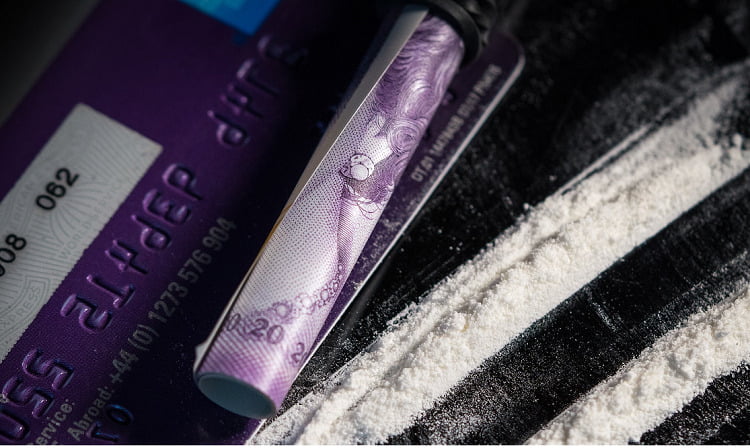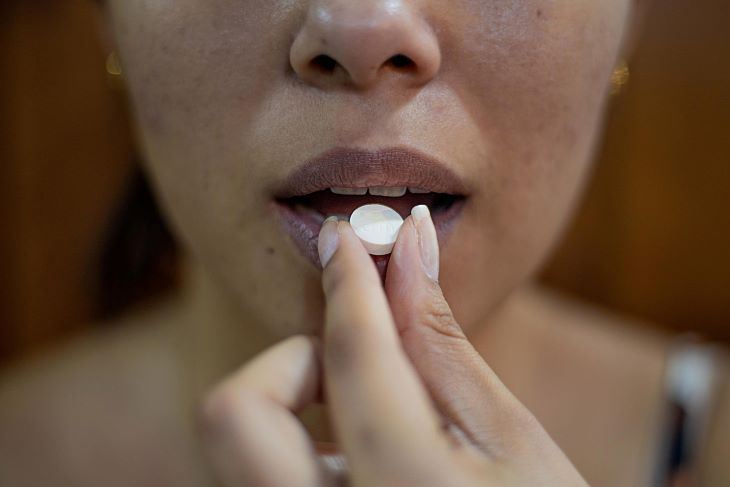It’s likely you’ve heard that crack and cocaine are the same drug, hence, landing on this page.
While these two forms of cocaine come from the same source and are chemically the same, there are some clear differences between crack and cocaine that are worth knowing about.
This drug is a stimulant that affects the central nervous system and is highly addictive.
In 2020, cocaine was the second most commonly used drug in England and Wales. Cocaine use has grown 4 times the amount that it was in 1995.[1] Crack cocaine use is also on the rise. There are around 5.1 crack users per 1000 people in England.[2]
Cocaine production is found in Bolivia, Columbia, and Peru. It’s made in “illegal labs” in the South American jungle. 90% of the cocaine that ends up in the US is from Columbia. [3]
The main cocaine route to the UK is from Columbia to the Caribbean via light aircraft after which it’s transferred into a cargo ship.[4]
The Difference between Crack and Cocaine

Crack gets its name from how it crackles when it’s heated and smoked. It’s a form of cocaine powder that’s been through a process:
- Cocaine is also known as snow, flake, white, salt, and bag.
- Crack-cocaine is also known as rock, gravel, stones, base, and badrock.
There are key areas where you can see the differences between crack and cocaine:
- Appearance
- Constitution – what’s in it exactly?
- How the substance is used
- The desired and side effects
- The health risks
- The social perception
What do Crack and Cocaine look like?
In appearance, these substances look different.
Cocaine comes as a crystalline white powder that can have a shine to it. Crack (or crack cocaine) is the cocaine base that comes in rock form. It’s usually whitish in colour and the rocks are of various shapes and sizes.
What Actually Are Cocaine and Crack?
In its original, natural form, this substance is an alkaloid drug that comes from the coca plant. A plant that stands around 8 feet tall.
The coca in the leaves is refined into a paste and then processed into powdered cocaine. The chemical name is “cocaine hydrochloride”.
Crack cocaine is created when cocaine is combined with water and baking soda. This mixture is “boiled” in the water, then the baking soda is removed leaving a highly concentrated and very powerful and addictive substance.
The process removes the hydrochloride salt (which has no psychoactive effects) making the drug more potent.
While they look different, there aren’t any chemical differences between crack and cocaine.
How Do People Take Crack and Cocaine?
There are a few different methods that people use when doing cocaine and crack.
Cocaine is most commonly snorted and absorbed through the nose cartilage into the bloodstream. However, some users opt to put cocaine in water in order to inject it straight into the veins and bloodstream. When injected, the high arrives more quickly and it’s more intense
In relation to snorting cocaine, it takes around 1-5 minutes to feel an effect, the peak lasts around 30 minutes and after around 1-2 hours, the effects usually disappear.
Crack is smoked and therefore absorbed through the lungs. This brings a quicker onset and more intense high. However, the high doesn’t last as long as it does when a user snorts. There is an immediate effect, the peak hits in around 3 to 5 minutes, and the high lasts around 30–60 minutes.
What are the Effects of Crack and Cocaine?
Firstly, both crack and cocaine have local anaesthetic properties, as well as this, they’re psychoactive substances with stimulant effects.
This means that they affect brain functioning and there are physiological effects throughout the system.
It needs to be pointed out that the effects of cocaine and crack can vary according to the purity of the substance. It’s unpredictable.
The effects of crack and cocaine include:
- Euphoria or the “buzz” people seek
- Numbness of mouth and face, or site of injection
- Alertness
- Restlessness and paranoia
- Aggressive mood swings
- Suppressed appetite
- Diarrhoea
- Dilated pupils
- Increased heart rate
- Heart palpitations and heart attack
- Stroke
What are the Health Risks of Crack and Cocaine?
As narcotic drugs, crack and cocaine addiction is a huge risk when using either. We’ll consider the addictive side of use and then look at the health risks associated with long-term use.
Cocaine and Crack Addiction and Withdrawal
Using psychoactive substances changes how the brain works. It releases chemicals that make you feel a particular way. For some people, this can feel so pleasurable that they return to the drug to experience it again.
When this starts to happen regularly, cocaine or crack addiction can develop because the brain and body come to require the drug to function. The system has become used to the substance being present and relies on it to feel “normal” (i.e. awake or energised).
This means that stopping use leads to cravings. Regular use leads to tolerance so people take more to feel an effect or just to function.
Ongoing Health Risks
Obviously using substances introduces toxins to the body. It’s mainly the job of the liver to rid the system of toxins but because of the time this takes, the toxins can stay in the body a long time, especially where there is repeated drug use.
There are therefore long-term effects of addictive cocaine and crack use.
These include:
Physical health risks
- Erosion of nose cartilage. It thins with repeated snorting and this can lead to infections. It’s also swallowed when taken up the nose and can affect the digestive system leading to ulcers and stomach cancers.
- Skin sores
- Collapsed veins if injected
- Reduced immunity – more colds and flu
- Increased risk of cancer
- Cardiac arrhythmias and heart attack
- Stroke
- “Crack lung” – leading to tumours and cancer in the lungs
- Breathing problems
Psychological health risks
- Low mood/depression and suicidal thoughts
- Anxiety disorder and agitation
- Paranoia
- Insomnia
- Apathy
- Hallucinations in crack users
The Risk of Overdose
Of course, overdose is also a real risk for cocaine and crack users.
One research paper described cocaine overdose as “psychomotor agitation, dilated pupils, tachycardia, hypertension, and hyperthermia. In addition, cocaine causes… seizures, myocardial ischemia/infarction, ventricular dysrhythmias, rhabdomyolysis, and multisystem organ dysfunction.” [5]
In layman’s terms, an overdose can lead to convulsions, coma, and at its worse, death.
History and Social Perception Around Crack and Cocaine

There are huge images of what cocaine’s “cracked up” to be in the media. It’s an expensive substance costing anywhere from £60-100 for a gram. It’s glamourised in films and TV shows and we associate it with the rich and famous.
Crack cocaine, on the other hand, is the cheaper alternative that costs around £10-20 for a rock. There’s a massive stigma attached to crack-cocaine use and those who use it.
Despite the two being the same chemically, cocaine is almost seen as a “cool” thing to do. Its rise in use in recent years is largely seen in younger and professional populations.
Looking at the history of cocaine, it’s notoriously known for being one of the original ingredients in Coca-Cola. That’s where the brand’s name came from when the drink was marketed as a way to tackle fatigue and headaches. Cocaine was removed from the drink in 1929 when the health effects had become clear.
It’s also a substance that was used in dentistry as an anaesthetic. In the 1800s, there was one doctor who trialled cocaine in the treatment of cancer (of course, now we know regular cocaine use more than doubles the risk of cancer).
In relation to cocaine and crack, there’s a history – specifically in the US – in relation to how black people and white people were treated differently in the judicial system in accordance to possession.
In the US in the 1980s there was a crack epidemic (this is the same decade crack hit the UK).
A 5-year minimum and mandatory sentence was brought in for people in possession of 5 grams or more of crack, whereas for cocaine possession the 5-year sentence wasn’t mandatory and might only be enforced with at least 500 grams of cocaine.
What this meant is that African Americans became targets during this epidemic in the US. At the time, crack was used a lot within black communities.
While cocaine was used in white communities, enforcement wasn’t mandatory and people weren’t prosecuted even if in possession of far greater amounts of cocaine.
Interesting, considering these substances have the same chemical makeup and crack is derived from cocaine.
The Fair Sentencing Act of 2010 removed the mandatory sentence around crack possession.
Currently, in the UK, cocaine is a class A illegal drug just as crack is. Possession of either can result in a sentence of up to 7 years.
Common Patterns in Cocaine and Crack Use

There are more cocaine users than crack users. Despite being an illicit drug, cocaine is associated with being used by affluent people living in affluent areas. This isn’t the present-day reality, however, cocaine use is used across socio-economic groups especially as supply has increased.
It’s true, however, that crack tends to be more commonly used by people from lower socio-economic groups. This is likely to do with the cost.
There’s also an increasing trend that people seem to move on to crack if they were addicted to cocaine and begin to struggle financially.
It was recently reported that there are “better cocaine use outcomes” in treatment for those who snort cocaine as opposed to those who smoke it.[6]
It’s safe to assume that this is linked to the higher potency of crack as well as, possibly, more barriers around, and fewer rehabilitation options, for people from lower socio-economic groups.
Treatment for Crack and Cocaine Use

If you have a cocaine or crack addiction, it’s important to get in contact with addiction and medical professionals in order to treat the condition. In the UK, there are both inpatient and outpatient treatments available.
Outpatient services are funded through the NHS and are available to anyone requiring support who is in active addiction. There are weekly groups and some one-to-one support.
Inpatient clinics, more commonly referred to as rehab centres, are the private option that is available to people with moderate to severe addictions who are ready to quit.
There you receive a personalised treatment plan and are given a range of psychological and alternative therapies to support an abstinent life into the future.
Cocaine Anonymous is available online and in some cities in person. It’s a 12 Step group that supports anyone with a cocaine or crack addiction to recover through the peer support approach.
It might become apparent that you have two co-occurring disorders such as cocaine addiction and anxiety, depression, or psychosis.
When there are two conditions, it’s especially important to seek professional help. Rehab clinics offer specialised packages aimed at treating mental health alongside addiction.
You can find out what your local rehab clinics are by contacting OK Rehab.
Final Thoughts…
While being the same chemically, cocaine and crack have a lot of differences from how they look to how people use them to how they’re viewed from a social point of view. Both lead to serious health effects if used regularly.
Crack and cocaine abuse is best treated through rehabilitation support. At a private clinic, you can get all the support you need and develop the skills to remain substance-free into the future.
Contact OK Rehab for more information about private clinical treatment.
FAQs
What’s the Difference Between Crack and Cocaine?
There are many differences between crack and cocaine. Crack is the base form of cocaine and looks like a rock whereas cocaine is in powder form. Crack is smoked and cocaine is usually snorted although is sometimes injected.
What Is the Legal Difference Between Crack and Cocaine?
In the UK, both crack and cocaine are class A drugs. Possession holds up to a seven-year sentence and supply holds up to a lifetime sentence.
Can crack cocaine cause health issues down the road after you’re sober?
Yes, crack cocaine can cause health issues after becoming sober. It’s advisable to contact medical professionals for support on how to improve health and immunity overall.
References
[3] https://www.dea.gov/sites/default/files/2020-06/Cocaine-2020_1.pdf
[4] https://www.themix.org.uk/drink-and-drugs/drugs-trade/how-do-drugs-get-into-the-uk-9814.html
[5] https://www.sciencedirect.com/science/article/pii/B9780123864543006849





